
Photo from wikipedia
Calcined layered double hydroxides (LDHs) can be used to remove Sb(V), in the Sb(OH)6− form, from aqueous solutions. Sorption batch experiments showed that the mixed MgAlFe oxides, obtained from calcined… Click to show full abstract
Calcined layered double hydroxides (LDHs) can be used to remove Sb(V), in the Sb(OH)6− form, from aqueous solutions. Sorption batch experiments showed that the mixed MgAlFe oxides, obtained from calcined hydrotalcite-like compound (3HT-cal), removed Sb(OH)6− through the formation of a non-LDH brandholzite-like compound, whereas the mixed ZnAl oxides, resulting from calcined zaccagnaite-like compound (2ZC-cal), trapped Sb(OH)6− in the interlayer during the formation of a Sb(V)-bearing LDH (the zincalstibite-like compound). The competition effect of coexistent anions on Sb(OH)6− removal was HAsO42− >> HCO3− ≥ SO42− for 2ZC-cal and HAsO42− >> HCO3− >> SO42− for 3HT-cal. Considering the importance of assessing the practical use of calcined LDHs, batch experiments were also carried out with a slag drainage affected by serious Sb(V) pollution (Sb = 9900 μg/L) sampled at the abandoned Su Suergiu mine (Sardinia, Italy). Results showed that, due to the complex chemical composition of the slag drainage, dissolved Sb(OH)6− was removed by intercalation in the interlayer of carbonate LDHs rather than through the formation of brandholzite-like or zincalstibite-like compounds. Both 2ZC-cal and 3HT-cal efficiently removed very high percentages (up to 90–99%) of Sb(V) from the Su Suergiu mine drainage, and thus can have a potential application for real polluted waters.
Journal Title: Crystals
Year Published: 2019
Link to full text (if available)
Share on Social Media: Sign Up to like & get
recommendations!